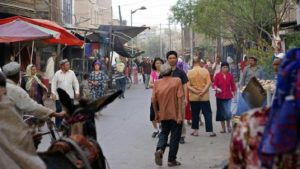
The persecution of Muslim Uyghurs is the worst public relation disaster for the CCP since the massive repression of Falun Gong in the 2000s. Why are they doing it?
Massimo Introvigne
The Universal Periodic Review of China on November 6, 2018, confirmed that the internment of roughly one million Uyghurs in the dreaded transformation through education camps is the worst public relation disaster for the Chinese Communist Party (CCP) after the large-scale persecution of Falun Gong in the 2000s. Chinese diplomats, and the Chinese deputy Minister of Foreign Affairs, had to hear country after country denouncing the persecution of the Uyghurs. Why are the Chinese doing it?
There are two easy, but false or at best incomplete, answers. The first is that the CCP does not like religion in general. This is true, but does not explain why the persecution of Uyghurs has escalated to the present dramatic figures in recent years. The CCP always disliked religion. Why does it crack down on the Uyghurs on such a massive scale now?
The second answer is that the CCP is afraid of Uyghur “separatism” and “terrorism.” This is of course the CCP’s own party line. And the CCP spares no effort to sell this to international media and governments. Although results are increasingly disappointing for the CCP, some media occasionally still repeat this explanation.
There is a kernel of truth in these claims, which are however developed by the CCP propaganda to propose two falsehoods. The kernel of truth is that some small terrorist organizations that preach an ultra-fundamentalist Islam do exist in Xinjiang. All statistics in this field are political. Chinese authorities claim that terrorist attacks in the 21st centuries have caused some 700 casualties. Uyghurs maintain that the number is inflated. But some terrorist attacks did occur, some Uyghurs did express sympathies for al-Qa’ida (which in turn tried to profit of the Uyghur cause in its propaganda) and a small number of Uyghurs joined ISIS (300 according to the Chinese, slightly more than 100 according to independent observers). There were also riots in 2009 in Xinjiang’s capital, Urumqi, when Uyghurs protested the brutality of the police, which left (according to official statistics) 197 dead, most of them Chinese Han. But the brutal CCP repression that followed may have made just as many victims.
These facts lead CCP propaganda to two false conclusions. The first is that most Uyghur sympathize with the terrorists. This is an unproved claim, used to keep one million Uyghurs in transformation through education camps. In fact, most Uyghur leaders and organizations have firmly rejected terrorism. The second faulty conclusion is that inaugurating a regime of terror in Xinjiang and putting a significant percentage of the population between bars would eradicate terrorism. The opposite is true. Almost all international scholars of terrorism who have studied the Uyghur case have concluded that the current wave of indiscriminate repression is the best recipe for allowing the so far small and unpopular terrorist groups to find some recruits in Xinjiang.
It should also be noted that the CCP classify as “terrorism” all forms of criticism of the regime, and all political activities calling for independence, or a real autonomy, of the region. This does not correspond to the usual definitions of “terrorism.”
For a better understanding of what is going on, it seems necessary to explain who are the Uyghurs. The name “Uyghurs” designated the subjects of the Uyghur Khaganate, a vast empire that existed in the 8th and 9th centuries. The Chinese Tang Dynasty defeated and conquered the Khaganate, which led to the migration of many Uyghurs from present-day Mongolia to present-day Xinjiang, where they merged with a local population of very ancient origin and later converted to Islam through a gradual process that started in the 10th century. By that time, the name “Uyghurs” was rarely used and the area inhabited by these Turkic Muslims was mostly called Altishahr (“Six Cities”).
The Buddhist Dzungar Khanate (based on what is today the northern part of Xinjiang) conquered Altishahr in the 17th century. This persuaded some Muslim inhabitants of the region (but not all) to side with the Chinese Qing Dynasty when it waged war against the Dzungar Khanate. A succession of wars ended in the 18th century with what historians called the Dzungar Genocide, when Chinese repression, disease, and famine caused the death of 500,000 to 800,000 Dzungars. The Muslims of Altishahr passed from Dzungar to Chinese rule, until Uzbek warlord Yakub Beg (1820–1877) rallied Muslims of the area against China and established a Muslim kingdom. China defeated against Beg in 1866, and in 1874 annexed the region calling it Xinjiang, which means “New Frontier” or “New Borderland.” At this stage, the name “Uyghurs” was used only to designate the medieval inhabitants of the Uyghur Khaganate. The Muslims of what the Chinese had called “Xinjiang” were called “Turki,” “Turban-headed,” or simply “Muslims.”
The name “Uyghurs” resurfaced only in the 20th century, together with a movement that contested the annexation of Xinjiang to China, denounced Chinese colonialism and the use of the word “Xinjiang” for the region (which they proposed to call “East Turkestan”), and called for independence. These claims found an ally in the Soviet Union, which believed that “Uyghuristan” can become just another Soviet Republic with a Muslim majority, as had been the case for nearby Kyrgyzstan, Kazakhstan, Uzbekistan, Tajikistan, and Turkmenistan. This created a complicated political, diplomatic, and military game between the Soviets and Nationalist China. Twice, with Soviet help and protection, ephemeral independent East Turkestan Republics were established in Xinjiang, the first in 1933–34 and the second in 1944–49.
The CCP’s accession to power in China ended these experiments. Chairman Mao (1893–1976) proclaimed Xinjiang “autonomous,” but the autonomy always existed on paper only. In fact, ethnic Chinese Han were sent to live in Xinjiang en masse, although statistics are a matter of controversy. The number of Uyghurs in Xinjiang is also contested, with scholars believing it to be somewhere in the middle between the 8,6 million of the Chinese census (11 million counting other Muslims living in Xinjiang, including ethnic Kazakhs) and the 15 million claimed by Uyghur organizations abroad. The total number of inhabitants of Xinjiang is 21 million.
Most Uyghurs do not regard themselves as “Chinese,” as they have a different ethnicity, religion, and language. Most of them do not speak Chinese at all. There is no evidence, however, that most Uyghurs are politically “separatist” or support independence from China, although, here again, repression and persecution clearly fuel separatism. Parenthetically, Bitter Winter is a magazine devoted to human rights and religious liberty. We do not take a position on political issues, such as what regions are or are not part of China. We use “Xinjiang” just as the most common and understandable designation of the area.
There is, also, no evidence that Uyghur separatism became more prevalent in the last decades, while there is ample evidence that persecution of the Uyghurs by the CCP did. Why, again, did this happen? Most scholars believe, and I agree with them, that the reasons are religious more than political. The (slightly) more lenient CCP politics under Deng Xiaoping (1904–1997) allowed the Islamic revival that affected all of Central Asia to extend to Xinjiang. At the same time, the collapse of the Soviet Union eliminated the old Chinese fear that crackdowns on the Muslims in Xinjiang may lead the Soviets to revive their projects of creating a Soviet-controlling “Uyghuristan” in an area of crucial strategic importance. President Xi Jinping’s policy of increasing crackdown on religion in general was the final factor that created the present situation.
Why are Uyghur persecuted? Although fears of “separatism” may play a role, basically the answer is that they are persecuted because the strong revival of Islam among them scared the regime. The CCP was, and is, afraid that the Muslim revival may expand to other non-Uyghur Muslim groups in China, and join forces with a revival of religion in general that may one day overcome the CCP’s rule. The logical conclusion is that, although no persecution is ever purely religious, the Uyghurs are indeed victims of a religious persecution.
Source:Bitter Winter / Massimo Introvigne



